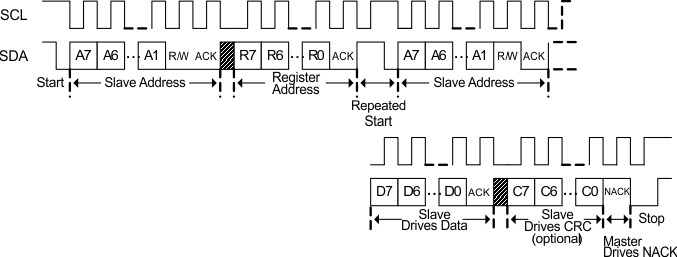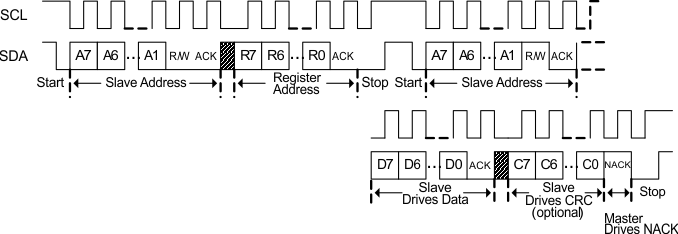JAJSKT5B September 2020 – January 2022 BQ769142
PRODUCTION DATA
- 1 特長
- 2 アプリケーション
- 3 概要
- 4 Revision History
- 5 Device Comparison Table
- 6 Pin Configuration and Functions
-
7 Specifications
- 7.1 Absolute Maximum Ratings
- 7.2 ESD Ratings
- 7.3 Recommended Operating Conditions
- 7.4 Thermal Information BQ769142
- 7.5 Supply Current
- 7.6 Digital I/O
- 7.7 LD Pin
- 7.8 Precharge (PCHG) and Predischarge (PDSG) FET Drive
- 7.9 FUSE Pin Functionality
- 7.10 REG18 LDO
- 7.11 REG0 Pre-regulator
- 7.12 REG1 LDO
- 7.13 REG2 LDO
- 7.14 Voltage References
- 7.15 Coulomb Counter
- 7.16 Coulomb Counter Digital Filter (CC1)
- 7.17 Current Measurement Digital Filter (CC2)
- 7.18 Current Wake Detector
- 7.19 Analog-to-Digital Converter
- 7.20 Cell Balancing
- 7.21 Cell Open Wire Detector
- 7.22 Internal Temperature Sensor
- 7.23 Thermistor Measurement
- 7.24 Internal Oscillators
- 7.25 High-side NFET Drivers
- 7.26 Comparator-Based Protection Subsystem
- 7.27 Timing Requirements - I2C Interface, 100kHz Mode
- 7.28 Timing Requirements - I2C Interface, 400kHz Mode
- 7.29 Timing Requirements - HDQ Interface
- 7.30 Timing Requirements - SPI Interface
- 7.31 Interface Timing Diagrams
- 7.32 Typical Characteristics
- 8 Device Description
- 9 Device Configuration
-
10Measurement Subsystem
- 10.1 Voltage Measurement
- 10.2 General Purpose ADCIN Functionality
- 10.3 Coulomb Counter and Digital Filters
- 10.4 Synchronized Voltage and Current Measurement
- 10.5 Internal Temperature Measurement
- 10.6 Thermistor Temperature Measurement
- 10.7 Factory Trim of Voltage ADC
- 10.8 Voltage Calibration (ADC Measurements)
- 10.9 Voltage Calibration (COV and CUV Protections)
- 10.10 Current Calibration
- 10.11 Temperature Calibration
- 11Primary and Secondary Protection Subsystems
-
12Device
Hardware Features
- 12.1 Voltage References
- 12.2 ADC Multiplexer
- 12.3 LDOs
- 12.4 Standalone Versus Host Interface
- 12.5 Multifunction Pin Controls
- 12.6 RST_SHUT Pin Operation
- 12.7 CFETOFF, DFETOFF, and BOTHOFF Pin Functionality
- 12.8 ALERT Pin Operation
- 12.9 DDSG and DCHG Pin Operation
- 12.10 Fuse Drive
- 12.11 Cell Open Wire
- 12.12 Low Frequency Oscillator
- 12.13 High Frequency Oscillator
- 13Device Functional Modes
- 14Serial Communications Interface
- 15Cell Balancing
- 16Application and Implementation
- 17Power Supply Requirements
- 18Layout
- 19Device and Documentation Support
- 20Mechanical, Packaging, Orderable Information
14.2 I2C Communications
The I2C serial communications interface in the BQ769142 device acts as a slave device and supports rates up to 400 kHz with an optional CRC check. If the OTP has not been programmed, the BQ769142 device will initially power up by default in 400 kHz I2C mode, although other versions of the device may initially power up in a different mode, as described in the Device Comparison Table. The OTP setting can be programmed on the manufacturing line, then when the device powers up, it will automatically enter the selected mode per OTP setting. The host can also change the I2C speed setting while in CONFIG_UPDATE mode, then the new speed setting will take effect upon exit of CONFIG_UPDATE mode. Alternatively, the host can use the SWAP_TO_I2C() subcommand to change the communications interface to I2C immediately.
The I2C device address (as an 8-bit value including slave address and R/W bit) is set by default as 0x10 (write), 0x11 (read), which can be changed by configuration setting.
The communications interface includes programmable timeout capability, this should only be used if the bus will be operating at 100 kHz or 400 kHz. If this is enabled with the device set to 100 kHz mode, then the device will reset the communications interface logic if a clock is detected low longer than a tTIMEOUT of 25 ms to 35 ms, or if the cumulative clock low slave extend time exceeds ≈25 ms, or if the cumulative clock low master extend time exceeds 10 ms. If the timeouts are enabled with the device set to 400 kHz mode, then the device will reset the communications interface logic if a clock is detected low longer than tTIMEOUT of 5 ms to 20 ms. The bus also includes a long-term timeout if the SCL pin is detected low for more than 2 seconds, which applies whether or not the timeouts above are enabled.
I2C Write shows an I2C write transaction. Block writes are allowed by sending additional data bytes before the Stop. The I2C logic autoincrement the register address after each data byte.
When enabled, the CRC is calculated as follows:
- In a single-byte write transaction, the CRC is calculated over the slave address, register address, and data.
- In a block write transaction, the CRC for the first data byte is calculated over the slave address, register address, and data. The CRC for subsequent data bytes is calculated over the data byte only.
The CRC polynomial is x8 + x2 + x + 1, and the initial value is 0.
When the slave detects an invalid CRC, the I2C slave will NACK the CRC, which causes the I2C slave to go to an idle state.

Figure 14-1 I2C Write
I2C Read with Repeated Start shows a read transaction using a Repeated Start.

Figure 14-2 I2C Read with Repeated Start
I2C Read without Repeated Start shows a read transaction where a Repeated Start is not used, for example if not available in hardware. For a block read, the master ACKs each data byte except the last and continues to clock the interface. The I2C block will auto-increment the register address after each data byte.
When enabled, the CRC for a read transaction is calculated as follows:
- In a single-byte read transaction, the CRC is calculated beginning at the first start, so will include the slave address, the register address, then the slave address with read bit set, then the data byte.
- In a block read transaction, the CRC for the first data byte is calculated beginning at the first start and will include the slave address, the register address, then the slave address with read bit set, then the data byte. The CRC resets after each data byte and after each stop. The CRC for subsequent data bytes is calculated over the data byte only.
The CRC polynomial is x8 + x2 + x + 1, and the initial value is 0.
When the master detects an invalid CRC, the I2C master will NACK the CRC, which causes the I2C slave to go to an idle state.

Figure 14-3 I2C Read Without Repeated Start